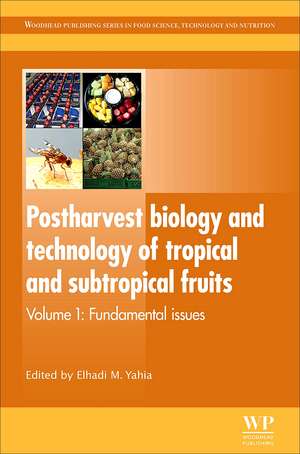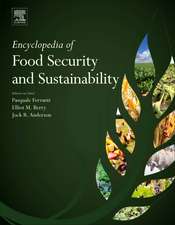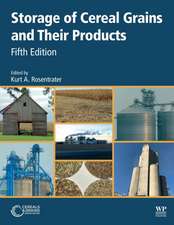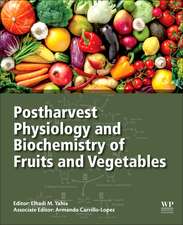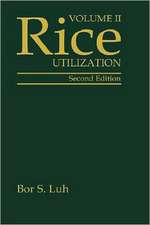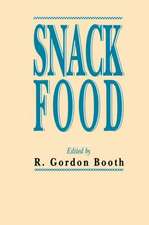Postharvest Biology and Technology of Tropical and Subtropical Fruits: Fundamental Issues: Woodhead Publishing Series in Food Science, Technology and Nutrition
Editat de Elhadi M. Yahiaen Limba Engleză Hardback – 18 sep 2011
- Along with the other volumes in the collection, Volume 1 is an essential reference for professionals involved in the postharvest handling and processing of tropical and subtropical fruits and for academics and researchers working in the area
- Focuses on fundamental issues of fruit physiology, quality, safety and handling relevant to all those in the tropical and subtropical fruits supply chain
- Chapters include nutritional and health benefits, preharvest factors, food safety, and biotechnology and molecular biology
| Toate formatele și edițiile | Preț | Express |
|---|---|---|
| Hardback (2) | 1049.04 lei 36-50 zile | |
| ELSEVIER SCIENCE – 18 sep 2011 | 1049.04 lei 36-50 zile | |
| ELSEVIER SCIENCE – 29 iun 2011 | 1135.13 lei 36-50 zile |
Din seria Woodhead Publishing Series in Food Science, Technology and Nutrition
- 15%
 Preț: 391.19 lei
Preț: 391.19 lei - 24%
 Preț: 1210.03 lei
Preț: 1210.03 lei - 24%
 Preț: 946.43 lei
Preț: 946.43 lei - 24%
 Preț: 960.56 lei
Preț: 960.56 lei - 23%
 Preț: 1419.50 lei
Preț: 1419.50 lei - 9%
 Preț: 1205.99 lei
Preț: 1205.99 lei - 24%
 Preț: 1189.10 lei
Preț: 1189.10 lei - 9%
 Preț: 1006.66 lei
Preț: 1006.66 lei - 9%
 Preț: 984.09 lei
Preț: 984.09 lei - 9%
 Preț: 1206.85 lei
Preț: 1206.85 lei - 24%
 Preț: 1081.43 lei
Preț: 1081.43 lei - 24%
 Preț: 1185.22 lei
Preț: 1185.22 lei - 9%
 Preț: 922.07 lei
Preț: 922.07 lei - 24%
 Preț: 1192.22 lei
Preț: 1192.22 lei - 9%
 Preț: 1215.75 lei
Preț: 1215.75 lei - 24%
 Preț: 1162.37 lei
Preț: 1162.37 lei - 9%
 Preț: 950.09 lei
Preț: 950.09 lei - 24%
 Preț: 1162.62 lei
Preț: 1162.62 lei - 24%
 Preț: 801.31 lei
Preț: 801.31 lei - 27%
 Preț: 379.84 lei
Preț: 379.84 lei - 29%
 Preț: 1336.07 lei
Preț: 1336.07 lei - 24%
 Preț: 798.74 lei
Preț: 798.74 lei - 24%
 Preț: 1333.02 lei
Preț: 1333.02 lei - 9%
 Preț: 1018.93 lei
Preț: 1018.93 lei - 31%
 Preț: 922.77 lei
Preț: 922.77 lei - 9%
 Preț: 1045.58 lei
Preț: 1045.58 lei - 24%
 Preț: 1131.77 lei
Preț: 1131.77 lei - 23%
 Preț: 1635.83 lei
Preț: 1635.83 lei - 9%
 Preț: 1277.62 lei
Preț: 1277.62 lei - 24%
 Preț: 1134.60 lei
Preț: 1134.60 lei - 9%
 Preț: 1076.36 lei
Preț: 1076.36 lei - 24%
 Preț: 1158.21 lei
Preț: 1158.21 lei - 9%
 Preț: 1065.06 lei
Preț: 1065.06 lei - 9%
 Preț: 1067.39 lei
Preț: 1067.39 lei - 24%
 Preț: 812.03 lei
Preț: 812.03 lei - 9%
 Preț: 1203.13 lei
Preț: 1203.13 lei - 23%
 Preț: 1237.19 lei
Preț: 1237.19 lei - 24%
 Preț: 948.79 lei
Preț: 948.79 lei - 23%
 Preț: 1138.06 lei
Preț: 1138.06 lei - 9%
 Preț: 868.43 lei
Preț: 868.43 lei - 24%
 Preț: 871.98 lei
Preț: 871.98 lei - 20%
 Preț: 1272.59 lei
Preț: 1272.59 lei - 29%
 Preț: 1195.06 lei
Preț: 1195.06 lei - 9%
 Preț: 1002.45 lei
Preț: 1002.45 lei - 9%
 Preț: 505.72 lei
Preț: 505.72 lei - 9%
 Preț: 1062.13 lei
Preț: 1062.13 lei - 24%
 Preț: 1306.94 lei
Preț: 1306.94 lei
Preț: 1049.04 lei
Preț vechi: 1372.26 lei
-24% Nou
Puncte Express: 1574
Preț estimativ în valută:
200.73€ • 210.14$ • 166.09£
200.73€ • 210.14$ • 166.09£
Carte tipărită la comandă
Livrare economică 31 martie-14 aprilie
Preluare comenzi: 021 569.72.76
Specificații
ISBN-13: 9781845697334
ISBN-10: 1845697332
Pagini: 534
Dimensiuni: 156 x 234 x 35 mm
Greutate: 0.87 kg
Editura: ELSEVIER SCIENCE
Seria Woodhead Publishing Series in Food Science, Technology and Nutrition
ISBN-10: 1845697332
Pagini: 534
Dimensiuni: 156 x 234 x 35 mm
Greutate: 0.87 kg
Editura: ELSEVIER SCIENCE
Seria Woodhead Publishing Series in Food Science, Technology and Nutrition
Cuprins
Contributor contact details
Woodhead Publishing Series in Food Science, Technology and Nutrition
Dr Adel Kader
Foreword
Preface
Chapter 1: Economic importance of tropical and subtropical fruits
Abstract:
1.1 Introduction
1.2 World fruit production and contribution to gross domestic product (GDP)
1.3 Global consumption of tropical and subtropical fruits
1.4 International trade in tropical and subtropical fruit
1.5 Price of tropical and subtropical fruit
1.6 Conclusions
Chapter 2: Nutritional and health-promoting properties of tropical and subtropical fruits
Abstract:
2.1 Introduction
2.2 Consumption
2.3 Health components of tropical and subtropical fruits
2.4 Bioactive compounds and antioxidant capacity
2.5 Overview of health effects of some tropical and subtropical fruits
2.6 Preharvest factors affecting accumulation of nutritional and health components
2.7 Postharvest factors affecting nutritional and health components
2.8 Enhancement of nutritional and health components in tropical and subtropical fruits
2.9 Conclusions
Chapter 3: Postharvest biology of tropical and subtropical fruits
Abstract:
3.1 Introduction
3.2 Diversity in fruit characteristics
3.3 Maturation and ripening
3.4 Quality attributes
3.5 Biological factors affecting deterioration
3.6 Environmental factors affecting deterioration
3.7 Pathological disorders and insect infestation
3.8 Biotechnological approaches for improving quality andpostharvest life
3.9 Conclusions
Chapter 4: Preharvest and harvest factors infl uencing the postharvest quality of tropical and subtropical fruits
Abstract:
4.1 Introduction
4.2 Genetic factors
4.3 Environmental factors
4.4 Physico-chemical factors
4.5 Diseases
4.6 Other factors
4.7 Harvesting factors
4.8 Phytohormones and other growth regulators
4.9 Conclusions
Chapter 5: Postharvest technologies to maintain the quality of tropical and subtropical fruits
Abstract:
5.1 Introduction
5.2 Maturity and harvesting indices
5.3 Harvesting
5.4 Conditioning
5.5 Quality
5.6 The cold chain
5.7 Centralized packing operations
5.8 Ripening
5.9 Processing
5.10 Conclusions
Chapter 6: Postharvest pathology of tropical and subtropical fruit and strategies for decay control
Abstract:
6.1 Introduction
6.2 Preharvest and postharvest factors affecting disease development
6.3 Modes of infection by postharvest pathogens
6.4 Attack mechanisms
6.5 Fruit defense mechanisms
6.6 Major pathogens of subtropical and tropical fruits
6.7 Control of postharvest pathogens
6.8 Conclusions and future challenges
Chapter 7: Quarantine pests of tropical and subtropical fruits and their control
Abstract:
7.1 Introduction
7.2 Internal fruit feeders: an introduction
7.3 Diptera: Tephritidae
7.4 Lepidoptera: Tortricidae and Elachistidae
7.5 Coleoptera: mango seed weevil: Sternochetus mangiferae (Fabricius) (Curculionidae)
7.6 External fruit feeders
7.7 Control measures: an introduction
7.8 Preharvest control measures
7.9 Postharvest control measures
7.10 Conclusions
Chapter 8: Microbial safety of tropical and subtropical fruits
Abstract:
8.1 Introduction
8.2 Foodborne pathogens associated with tropical and subtropical fruit
8.3 Outbreaks of foodborne illness attributed to tropical and subtropical fruits
8.4 Routes of contamination of tropical fruits
8.5 Interventions to reduce contamination of tropical fruits
8.6 Food safety programs used to minimize microbial contamination of fruits
8.7 Conclusions
Chapter 9: Biotechnology and molecular biology of tropical and subtropical fruits
Abstract:
9.1 Introduction
9.2 Genetic transformation, transcriptome sequencing, genome mapping and sequencing of fruits
9.3 Acerola (Malpighia emarginata DC.)
9.4 Avocado (Persea americana Mill.)
9.5 Banana (Musa acuminata)
9.6 Cherimoya (Annona cherimola Mill.)
9.7 Citrus
9.8 Coconut (Cocos nucifera L.)
9.9 Date (Phoenix dactylifera L.)
9.10 Fig (Ficus carica L.)
9.11 Grape (Vitis vinifera L.)
9.12 Guava (Psidium guajava L.)
9.13 Kiwifruit (Actinidia deliciosa)
9.14 Litchi (Litchi chinensis Sonn.)
9.15 Longan (Dimocarpus longan Lour.)
9.16 Loquat (Eriobotrya japonica L.)
9.17 Mango (Mangifera indica L.)
9.18 Mangosteen (Garcinia mangostana L.)
9.19 Melon (Cucumis melo L.)
9.20 Nuts
9.21 Olive (Olea europaea L.)
9.22 Papaya (Carica papaya L.)
9.23 Passion fruit (Passiflora edulis Sim)
9.24 Pineapple (Ananas comosus L. Merr)
9.25 Sapodilla (Manilkara zapota)
9.26 Conclusions
Chapter 10: Fresh-cut tropical and subtropical fruit products
Abstract:
10.1 Fresh-cut produce industry worldwide
10.2 Handling and conditioning of raw materials for processing
10.3 Sanitation of whole and fresh-cut fruits
10.4 Mechanical and manual processing of fruits
10.5 Physiological and biochemical aspects of fresh-cut produce
10.6 Effects of peeling and cutting on overall quality: texture, flavour and colour
10.7 Preservative treatments for fresh-cut fruits
10.8 Preservation of bioactive compounds and antioxidant capacity
10.9 Nutritional aspects of fresh-cut vs whole fruits
10.10 Hazard Analysis Critical Control Point (HACCP) and hygiene considerations for the fresh-cut produce industry
10.11 Facilities, process design and equipment requirements
10.12 New trends in the fresh-cut fruit industry
10.13 Economic and market considerations
10.14 Conclusions
Chapter 11: Preservation and processing of tropical and subtropical fruits
Abstract:
11.1 Factors responsible for the deterioration of tropical fruits and their products
11.2 Microbiological aspects
11.3 Enzymes
11.4 Principles of conventional methods of preservation
11.5 Fruit preparation for preservation purposes
11.6 Refrigeration and freezing
11.7 Drying
11.8 Manufacture of fruit beverages and purees
11.9 Manufacture of jams and jellies
11.10 Heat treatments applied to fruit products
11.11 Non-thermal processes applied to tropical and subtropical fruit processing
11.12 Conclusions
Index
Woodhead Publishing Series in Food Science, Technology and Nutrition
Dr Adel Kader
Foreword
Preface
Chapter 1: Economic importance of tropical and subtropical fruits
Abstract:
1.1 Introduction
1.2 World fruit production and contribution to gross domestic product (GDP)
1.3 Global consumption of tropical and subtropical fruits
1.4 International trade in tropical and subtropical fruit
1.5 Price of tropical and subtropical fruit
1.6 Conclusions
Chapter 2: Nutritional and health-promoting properties of tropical and subtropical fruits
Abstract:
2.1 Introduction
2.2 Consumption
2.3 Health components of tropical and subtropical fruits
2.4 Bioactive compounds and antioxidant capacity
2.5 Overview of health effects of some tropical and subtropical fruits
2.6 Preharvest factors affecting accumulation of nutritional and health components
2.7 Postharvest factors affecting nutritional and health components
2.8 Enhancement of nutritional and health components in tropical and subtropical fruits
2.9 Conclusions
Chapter 3: Postharvest biology of tropical and subtropical fruits
Abstract:
3.1 Introduction
3.2 Diversity in fruit characteristics
3.3 Maturation and ripening
3.4 Quality attributes
3.5 Biological factors affecting deterioration
3.6 Environmental factors affecting deterioration
3.7 Pathological disorders and insect infestation
3.8 Biotechnological approaches for improving quality andpostharvest life
3.9 Conclusions
Chapter 4: Preharvest and harvest factors infl uencing the postharvest quality of tropical and subtropical fruits
Abstract:
4.1 Introduction
4.2 Genetic factors
4.3 Environmental factors
4.4 Physico-chemical factors
4.5 Diseases
4.6 Other factors
4.7 Harvesting factors
4.8 Phytohormones and other growth regulators
4.9 Conclusions
Chapter 5: Postharvest technologies to maintain the quality of tropical and subtropical fruits
Abstract:
5.1 Introduction
5.2 Maturity and harvesting indices
5.3 Harvesting
5.4 Conditioning
5.5 Quality
5.6 The cold chain
5.7 Centralized packing operations
5.8 Ripening
5.9 Processing
5.10 Conclusions
Chapter 6: Postharvest pathology of tropical and subtropical fruit and strategies for decay control
Abstract:
6.1 Introduction
6.2 Preharvest and postharvest factors affecting disease development
6.3 Modes of infection by postharvest pathogens
6.4 Attack mechanisms
6.5 Fruit defense mechanisms
6.6 Major pathogens of subtropical and tropical fruits
6.7 Control of postharvest pathogens
6.8 Conclusions and future challenges
Chapter 7: Quarantine pests of tropical and subtropical fruits and their control
Abstract:
7.1 Introduction
7.2 Internal fruit feeders: an introduction
7.3 Diptera: Tephritidae
7.4 Lepidoptera: Tortricidae and Elachistidae
7.5 Coleoptera: mango seed weevil: Sternochetus mangiferae (Fabricius) (Curculionidae)
7.6 External fruit feeders
7.7 Control measures: an introduction
7.8 Preharvest control measures
7.9 Postharvest control measures
7.10 Conclusions
Chapter 8: Microbial safety of tropical and subtropical fruits
Abstract:
8.1 Introduction
8.2 Foodborne pathogens associated with tropical and subtropical fruit
8.3 Outbreaks of foodborne illness attributed to tropical and subtropical fruits
8.4 Routes of contamination of tropical fruits
8.5 Interventions to reduce contamination of tropical fruits
8.6 Food safety programs used to minimize microbial contamination of fruits
8.7 Conclusions
Chapter 9: Biotechnology and molecular biology of tropical and subtropical fruits
Abstract:
9.1 Introduction
9.2 Genetic transformation, transcriptome sequencing, genome mapping and sequencing of fruits
9.3 Acerola (Malpighia emarginata DC.)
9.4 Avocado (Persea americana Mill.)
9.5 Banana (Musa acuminata)
9.6 Cherimoya (Annona cherimola Mill.)
9.7 Citrus
9.8 Coconut (Cocos nucifera L.)
9.9 Date (Phoenix dactylifera L.)
9.10 Fig (Ficus carica L.)
9.11 Grape (Vitis vinifera L.)
9.12 Guava (Psidium guajava L.)
9.13 Kiwifruit (Actinidia deliciosa)
9.14 Litchi (Litchi chinensis Sonn.)
9.15 Longan (Dimocarpus longan Lour.)
9.16 Loquat (Eriobotrya japonica L.)
9.17 Mango (Mangifera indica L.)
9.18 Mangosteen (Garcinia mangostana L.)
9.19 Melon (Cucumis melo L.)
9.20 Nuts
9.21 Olive (Olea europaea L.)
9.22 Papaya (Carica papaya L.)
9.23 Passion fruit (Passiflora edulis Sim)
9.24 Pineapple (Ananas comosus L. Merr)
9.25 Sapodilla (Manilkara zapota)
9.26 Conclusions
Chapter 10: Fresh-cut tropical and subtropical fruit products
Abstract:
10.1 Fresh-cut produce industry worldwide
10.2 Handling and conditioning of raw materials for processing
10.3 Sanitation of whole and fresh-cut fruits
10.4 Mechanical and manual processing of fruits
10.5 Physiological and biochemical aspects of fresh-cut produce
10.6 Effects of peeling and cutting on overall quality: texture, flavour and colour
10.7 Preservative treatments for fresh-cut fruits
10.8 Preservation of bioactive compounds and antioxidant capacity
10.9 Nutritional aspects of fresh-cut vs whole fruits
10.10 Hazard Analysis Critical Control Point (HACCP) and hygiene considerations for the fresh-cut produce industry
10.11 Facilities, process design and equipment requirements
10.12 New trends in the fresh-cut fruit industry
10.13 Economic and market considerations
10.14 Conclusions
Chapter 11: Preservation and processing of tropical and subtropical fruits
Abstract:
11.1 Factors responsible for the deterioration of tropical fruits and their products
11.2 Microbiological aspects
11.3 Enzymes
11.4 Principles of conventional methods of preservation
11.5 Fruit preparation for preservation purposes
11.6 Refrigeration and freezing
11.7 Drying
11.8 Manufacture of fruit beverages and purees
11.9 Manufacture of jams and jellies
11.10 Heat treatments applied to fruit products
11.11 Non-thermal processes applied to tropical and subtropical fruit processing
11.12 Conclusions
Index
Recenzii
"It is fair to say that this milestone publication could not have come at a better time." --Food and Beverage Reporter
